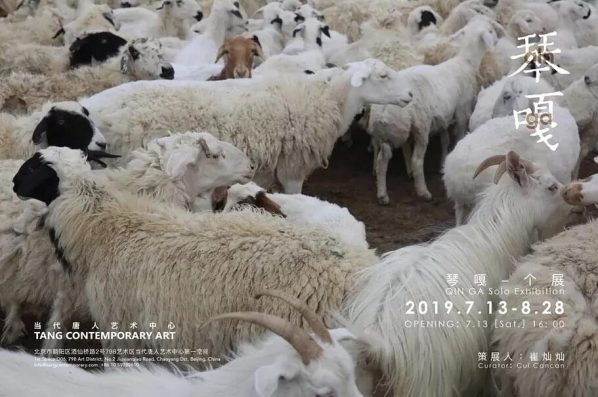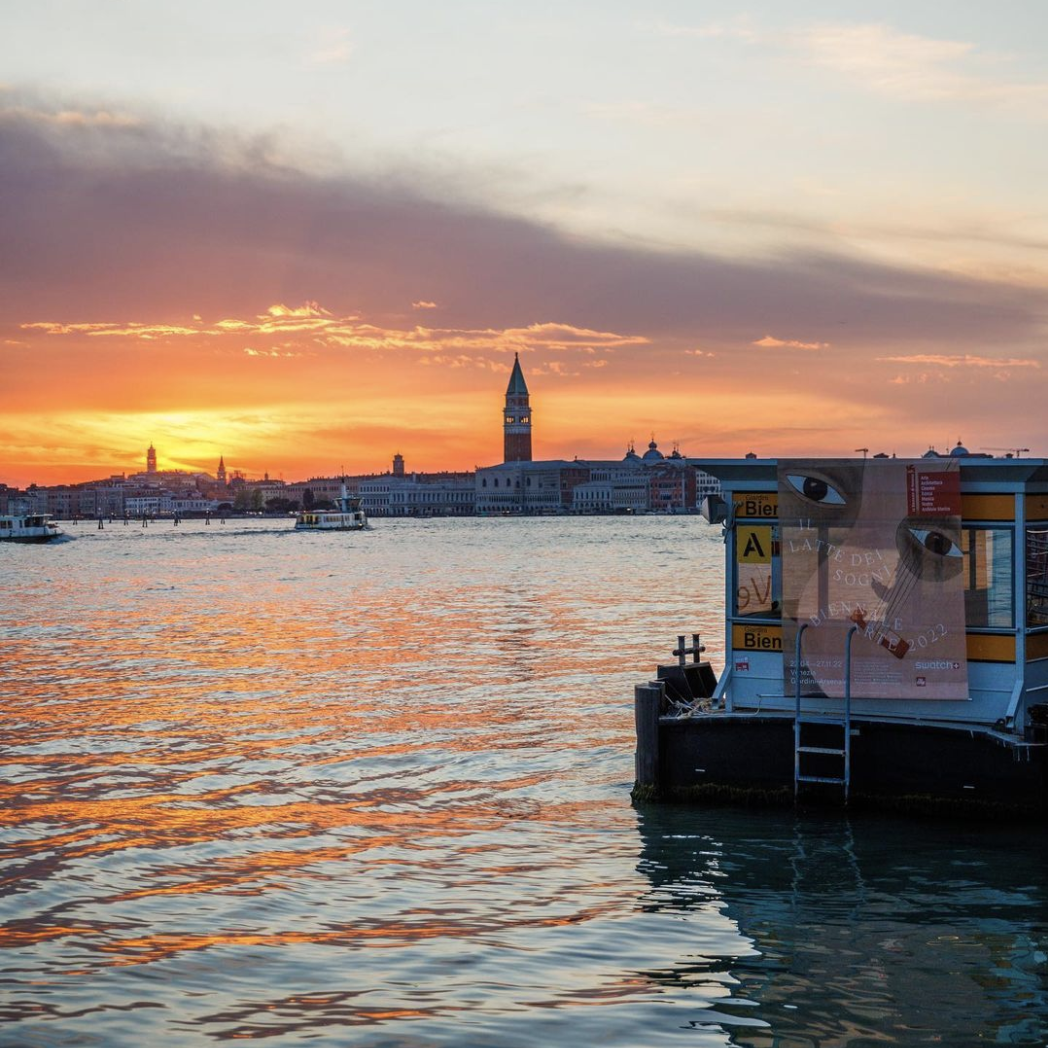
Tang Contemporary Art is pleased to announce the opening of Qin Ga, a solo exhibition for Qin Ga in the gallery's first Beijing space, on July 13, 2019. Curated by Cui Cancan, the exhibition will be Qin Ga's most important solo presentation in nearly ten years. The exhibition will showcase three important works: Where Are You Going, Belief, and Enclosure Project. Qin Ga's work begins with sculpture, but also incorporates videos, performances, photographs, social surveys, and institutions. The combination of several mediums presents the artist's thoughts about the nomadic cultural philosophy and the world it has constructed, as well as the concepts of sovereignty and boundaries in modern society.
Where Are You Going?
In 1998, Qin Ga presented Corridor-Diffusionat a three-person exhibition. “Horse heads” were mounted on both sides of the corridor. The space was full of primitive energy and mysterious ceremonies. This power stemmed from the place where Qin Ga grew up—the plains several hundred kilometers outside of Beijing. Here, ethnic totems and Mongolian blood and identity made their first appearance. At that time, people outside the plains did not know that the plains were shrinking and that nomadic lifestyles were changing. We did not know the difference between marshy and arid plains, and we might have thought that plains, wastelands, and deserts existed in different worlds, but they were actually very close to one another in nature. Now, water and grass are retreating, and desertification is spreading.
Today, corridor and diffusion, seemingly conflicting elements, may be part of a strategy that Qin Ga has continued to use, or a fissure in real existence that seduces people into endless visions of spatial relationships. Diffusion constantly appears in Qin Ga’s later artistic practice. He begins with sculpture, but he also employs videos, performances, photographs, social surveys, and organizations. The combined use of multiple methods does not prevent sculpture from appearing often in Qin Ga’s work; it is simply that he is no longer restrained by the language of traditional sculpture, and he returns sculpture to its most basic function—recording ephemeral situations in classic or symbolic moments. These moments are immensely important to Qin Ga’s spiritual journey. His work does not seem settled; it is comprised of countless temporary, flowing moments. Migrating on the plains, the herders have moved in search of grass and water for thousands of years.
In his two decades of artistic practice, Qin Ga’s work has undergone three changes. In1998, Qin Ga began to spend more time exploring individuals’ physical circumstances, the violence of reality and the taboos of society, cheap bodies, and even the dissolution of materiality. Freeze and Disinfect became important around the year 2000, bringing Qin Gato prominence in Chinese avant-garde art. However, these works still unfolded against the background of urban consumerism. In 2002, The Miniature Long March represented an escape from the urban context and collective malaise, but the project also brought him wider recognition and has been highlighted in many Chinese contemporary art exhibitions overseas. I have called it an escape, but it might be better to understand it as a search for identity. He asked: Where do individuals come from? What unique imprints do they carry? Plan for Disposing of My Remains in Bricks was an important transition, like a symbol of rebirth. Qin Ga planned to turn his bones into several rectangular bricks after his
death. The topic of death, which was usually taboo in agricultural society, obtained new meaning in Qin Ga’s nomadic lineage.
Life comes from nature, and death embraces a return to nature. All things in heaven and earth move in a cycle of life and death, guiding the (universal) individuals within Qin Ga’s work toward a new awareness of life and a new cultural identification. Later, the animals, culture, and philosophy of the Mongolian people appeared often in Honor, Hurray! Hurray! Hurray!, Territory, and Forest, becoming notable artistic languages and conceptual traits within Qin Ga’s work that made it unique in the Chinese contemporary art scene. Finding these imprints became an awakening of Qin Ga’s self-awareness. Birthmarks are unavoidable personal realities and nomadism is a special way of understanding and conceptualizing the world.
The shifting sands on the wasteland fill the sky. Young camels, horses, cattle, and sheep, some scattered remains, and different traces of space and time overlap and layer with various scenes from Qin Ga’s past work. Where Are You Going is a compilation of the various elements in Qin Ga’s twenty years of artistic practice, a combination of sculptures, performances, videos, and photographs, but it might be better to see the piece as an inquiry into the predicament of modern nomads. With the desert’s constant encroachment on the plains, pastoral songs have become sandstorms and only incomplete memories are left in these barely inhabited areas. When pastures and water sources, basic resources on which the herders rely, deteriorate or disappear, desiccated corpses and skeletons are the only evidence of the fact that nomads once existed.
Stone breakers brandishing stone axes in Quyang, Hebei, attempted to polish these animal sculptures; this was a finishing step, but it was also a conceptual strategy formulated by the artist. Workers that were imprinted by agriculture used cutting techniques from modern industry to refine sculptures of these five animals that have disappeared from nomadic civilization. The imprecise modeling appears correct but is just slightly off; the mismatch of agricultural and industrial civilization has become a contradiction in Qin Ga’s work. The identities and skills of agriculture are diametrically opposed to nomadic realities, and the cause-and-effect relationships between the two induce endless imagination in the viewer. Industrial exhaust fans imitate scenes from nature; the sandstorms look like ashes scattered all over the marble sculptures.
Which is longer—a moment or an eternity?
In Where Are You Going, time and space are displaced; it is a time and space in which a moment and an epic coexist. Stories happening several thousand kilometers away are being re-edited to include the artist’s silhouette, gestures, thoughts, and questions. The visitors are situated within it, and they must carefully differentiate and seek out the artist’s spatial magic. How did every one of them appear? Which complex yet conflicting relationships are present? Animals, bones, and sand, as well as air blowers, stonemasons, and the artist’s travels come from different times and spaces and have their own existential logics, cultural symbols, and historical backgrounds. They represent life and death, disaster and glory in every culture and they mix together. The mirrors of varying sizes on the wall reflect different perspectives, and when placed together, they have a mirage-like effect. We catch glimpses of the sand, sky, and white statues, remembering the distant life of the nomadic search for pastures and waters, until sandstorms block our vision and walking
only gets us in deeper. We are thrown into a wilderness world in which a direction cannot be discerned, and grains of sand attack us from all directions.
What causes unease? We are always hovering in a sense of crisis, but Belief provides another answer. In the corner of a room, seven butter lamps flicker in an antler chandelier. Its shape and meaning come from Mongolian history and culture, because these chandeliers were often used by nomadic aristocrats. Here, traditional antlers have been replaced with cast copper; industrialized production is imitating the texture of antlers. The chandelier rests heavily on the ground, the broken chain hanging from a frame. Only the butter lamps retain that primitive brightness; the lights gently swaying the breeze from the wilderness outside, but they cannot be scattered by changes in this mundane world. We sense it, and what we sense is the firm self-awareness, the “birthmarks” of lineage, and the unwavering belief in Qin Ga’s twenty years of artistic practice.
The meaning that the artist relates through symbolism is not easy to understand, but what’s interesting is that antler lamps, this product of hunting tribes, guides the story in another direction—Mongolian history and the story of a people that went from hunting in the mountains to herding sheep. Thus, the crisis is no longer a binary opposition between nomadic and agricultural lifestyles; the crisis returns to nomadism itself, examining its historical impact, change, and perpetuation. The question of where they are going has a broader historical meaning and engages with a much broader reality.
Where Are You Going and Belief begin with the real encounters between nomadism and hunting cultures, asking a larger question: Is it just these two ways of life that are dying? Or is it a regional crisis? Obviously, at a moment when free flows encounter numerous obstacles, people both rely on the city and detest it. Individuals are trained, and capital constructs the spectacles of society, both of which make breathing more difficult and cause us to wonder where we are going. Is the wasteland returning to a past civilization? The wasteland itself provides an answer. There is no utopian existence outside of cities; it is similarly overwhelmed with crises.
In 2014, Qin Ga began investigating the Alxa League on the west side of Inner Mongolia, moving from west to east. Long, narrow Inner Mongolia extends for thousands of kilometers in northern China. This journey was difficult; he traversed plains, deserts, hills, and rivers. This trip was different from a mere pleasure tour; he had to think everything over carefully and pass through time and space to listen to the voices of the past. When necessary, he had to sleep under the stars and work himself to the bone. Only in this way would the issues hidden in reality and the crises that are not easy to discern become gradually more obvious. Nature did not throw up obstacles on his journey; enclosures prevented him from moving forward on plains that seemed to stretch to the horizon. He was constantly climbing over these enclosures; they evoked modern industry through constructions of barbed wire that contained the potential for injury. Grassland Fence Project developed from this experience. Through geographical and social surveys, Qin Ga began the project in the Xilingol League in the eastern part of Inner Mongolia. When he chose to change the investigation, he traveled from west to east, creating two times and spaces and two decidedly different visions. He started with three perspectives: 1. He asked the herders he encountered along the way two questions: What do you think of enclosing the plains? Have you tried opening the enclosures? 2.He photographed the herders’ ways of working, including scenes of them shearing sheep in the summer and watering the animals in the winter.3. Along the way, he photographed marshes, deserts, plains, rivers, and mountains. Qin Ga recorded what he saw and heard in a nomadic fashion; his “working space” moved with the herders, and they shared the same honors and losses.
An ordinary, settled life engulfed by modernity and homogeneity reflects the herders’ use of enclosures and modern society’s emphasis on boundaries and sovereignty, which are cut off from traditional nomadic life. Personal economic interests and the need to expand production capacity have transformed modern society into a series of social projects. Therefore, grazing becomes the accumulation of capital labor force and cities, highlands, plains, and deserts become part of global industry. Nomadic culture has a harmonious relationship with and reverence for nature. The belief in the Creator’s laws and the view that all things are equal and interconnected are becoming more distant from the entanglements of modern society and capitalism. Grassland Fence Project is just the beginning; it will continue in Inner Mongolia. The core issues of this region are not just happening in several thousand kilometers on the map; they are playing out all over the world.
However, these ideas, which are being widely discussed today, are linked to the idea of “enclosure” and bring us back to the simplest of real lives. In his travels, Qin GA constantly asked herders about their opinions and collected various kinds of enclosures, recording classic or symbolic moments. In the exhibition hall, he creates for viewers a journey in space and time across the wilderness. When the sounds of stones striking blend with the winds and the pure marble is constantly covered with sand, Where Are You Going becomes a question that lingers in the mind. The spark of a nomadic life lies in another part of the brain, and it, like the light of seven small butter lamps, is sometimes bright and sometimes feeble.
Cui Cancan
July 7, 2019
About the artist
Qin Ga is an artist and the founder of Zao Space. He gained his bachelor's and master's degree in sculpture from the Central Academy of Fine Arts and is currently teaching at the Central Academy of Fine Arts. Since the late 1990s, his works have always been concerned with reality and coherence. His anti-aesthetic attitude enabled him to develop an ultra-daily personal preference and dependence on reality. His body carries the public memories and personal feeling to create a live work that breaks the viewer’s expectations and the line between the works to make the sculpture a turbulent one. At the meantime, he tries to blend the cognitive spirit of the nomadic culture with the actual experience and express the delusions of reality. In 2012, he established “Zao Space”, selecting social spaces in a nomadic manner, allowing art to take place in the social space, and in the face of very specific realities, initiated a number of artistic action projects. Major public collections include the Queensland Art Museum in Australia, the Czech National Gallery, the UBS Collections,
the M+ Museum in Hong Kong, and the Central Academy of Fine Arts.
About the exhibition
Opening: 2019.7.13 4 pm
Duration: 2019.7.13 - 8.28
Location: Tang Contemporary Art, 1st space, Beijing
Courtesy of the artist and Tang Contemporary Art, for further information please visit www.tangcontemporary.com.




























